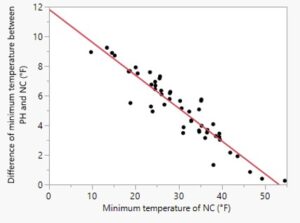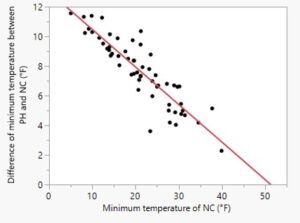This week, we experienced another round of very cold days, with minimum temperatures dropping into the single digits. Under these conditions, row covers are essential for helping plants survive and preventing cold damage even inside high tunnels.
The difference in the minimum temperatures inside and outside of high tunnels may not always be significant, as it depends on the tunnel’s insulation capability. However, using row covers inside a high tunnel can create a notable temperature increase.
There have been questions about how much warmth row covers can provide when used inside a high tunnel. To address this, we compared temperatures in two beds inside a high tunnel—one covered with a 1.5 oz/sq.yd (Agribon AG-50) row cover placed on a wire hoop, and the other left uncovered—over two winters at the Southwest Purdue Agricultural Center.
Our findings showed a strong negative correlation between the minimum temperature in the high tunnel and the temperature increase provided by the row covers. In other words, the colder the conditions inside the high tunnel, the greater the row cover’s warming effect.

Figure 1. Effect of row covers on temperature increase (y-axis) vs. minimum temperatures inside the high tunnel (x-axis) in 2022-2023 winter at the Southwest Purdue Agricultural Center [PH = passive cover (covered entire winter) on hoops; NC = no cover].

Figure 2. Effect of row covers on temperature increase (y-axis) vs. minimum temperatures inside the high tunnel (x-axis) in the 2021-2022 winter at the Southwest Purdue Agricultural Center [PH = passive cover (covered entire winter) on hoops; NC = no cover].
The varying effects of row covers in raising minimum temperatures are likely influenced by the amount of heat stored in the soil. Across Indiana, soil temperatures at a depth of 4–6 inches typically range between 40°F and 50°F during the winter. When air temperatures are similar to soil temperatures, row covers have little effect on increasing air temperatures at night.
When used inside high tunnels, row covers clearly provide significant protection on extremely cold nights. However, this protection may not be sufficient for less cold-hardy crops like lettuce, which could suffer damage when temperatures drop to 28°F. Successfully growing these crops in winter typically requires supplemental heating or a specifically designed structure.